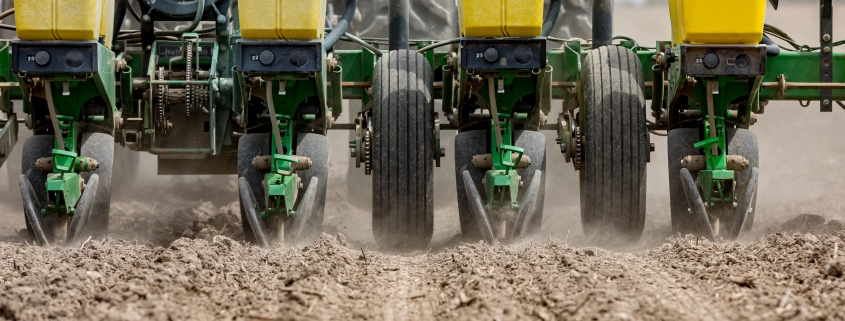IP Crop Network, May Report
This monthly feature from SSGA’s Agronomy Action Team highlights growing conditions for Identity Preserved crops from different regions around the country. Thanks to the states/regions that contributed this month. If you would like to contribute, please get in touch with David Kee or Shane Frederick. You should also follow David Kee on Twitter for some of the latest, most-interesting information on agronomy and research that affect IP and other farmers.
Illinois
Illinois has seen a lot of crop go in the ground in the past month. Corn is around 75% planted, and beans are around 68% planted. Until the rains this past weekend, some areas had become very dry, and emergence was being delayed because a lack of moisture. Most areas did receive enough rain to alleviate germination issues with some areas receiving way too much rain.
Wheat is progressing along and is fully headed and pollinated in the south. This “maturation line” will progress north at 75-100 miles per week. It looks to be an average crop with a lot of unevenness suppressing the top end yields.
— Scott Eversgerd, Field Agronomist, Southern Illinois, Pioneer Hi-Bred Int’l
Michigan
The planting season in Michigan has begun between periods of rain. The USDA estimated our soybean crop to be 15% planted as of May 7. This is very close to our five-year average of 16%. Although we are near average for this date on the calendar, growers are becoming a little anxious as the days pass with little field work. Corn planting is behind average at only 6%. This slow corn planting is mostly due to cold soil and air temperatures. This limited corn planting may delay soybean planting on some farms that use a single planter for both crops.
As most growers have great capacity for most field work, including planting, our planting progress can move forward quickly when conditions allow. Increasing soil temperatures and improving soil conditions hold promise for fast emergence and stand establishment.
— Mark Seamon, Research Director Michigan Soybean Committee
Minnesota
The recent rains have come as a mixed blessing. Farmers are raring to go, but crop planting has been limited in Minnesota. The delayed spring snow melt has resulted in widespread flooding in the northwest. However, according to the Drought Monitor, more than 40% of the state is rated in drought status D0-D1. USDA-NASS reports topsoil moisture supplies were rated 9% short to very short, 72% adequate, and 19% surplus. Subsoil moisture supplies were rated 14% short to very short, 72% adequate, and 14% surplus. During late April, soil temperature (4 inches deep) has stubbornly remained below 50oF across much of the state. The first few days of May sunshine will rapidly change that.
According to the lates USDA-NASS crop progress report, planting is well ahead of last year, but trails the five-year average. As soil conditions become appropriate, field work, pre-plant activities (fertilizer, some herbicides, etc.), and planting will occur, across the landscape, near simultaneously. There has been some talk that surplus moisture will result in requests for prevent plant status being filed on select fields (especially in the northwest). Things will be touch and go for a while, with many long days (and short nights) occurring, as the late spring has narrowed the planting window. But #plant23 will get done; it’s the Minnesota way!
— David Kee, Director of Research, Minnesota Soybean Research & Promotion Council
Missouri
The water faucet has shut off in Missouri. More than 50% of the state is designated abnormally dry or moderate drought. Many farmers across the state have eased up on planting to wait for some moisture. Rain is in the forecast for later this week to hopefully get us back on track. Many farmers have continued planting in the dry conditions, and planting progress has made some big jumps over the last couple weeks.
Corn is estimated to be 92% planted in the state with 56% of that planted crop emerged. Soybeans took a large jump over last week to reach 50% planted with 21% of the crop emerged. With our sunny days and warm temps, cotton took one of the largest acres-planted jump since May 1. As of May 8, 40% was planted, a new 35% gain in just seven days. Our rice crop is getting close to being planted with 85% of the crop in the soil with 61% of that crop emerged. Winter wheat ratings for today are 63% of the crop being “good” with 40% of it headed.
— Eric Oseland, Director of Agronomy and Research, Missouri Soybeans
Wisconsin
Warmer and drier conditions statewide have led to increased field work for the week ending May 14, 2023. According to the last USDA-NASS report, soybean in Wisconsin is estimated to be 24% planted, with 3% of that planted soybean emerged as of May 14. The soybean planting progress is only 6% behind the 5-year average (2018-2022). As of May 14, corn is estimated to be 33% planted but still lags behind the average by 12%. Furthermore, only 5% of the planted corn has emerged.
The slower progress in soybean and corn planting can be attributed to the wet and cold weather conditions at the beginning of the season. Additionally, some fields are still too wet for large equipment to function effectively. Moreover, the relative delay in corn planting progress can be attributed to growers prioritizing early-season soybean planting.
— Shawn Conley, State Extension Soybean and Small Grain Specialist, University of Wisconsin-Madison
Note: To see state Crop Progress reports from USDA’s National Agricultural Statistics Service (NASS): click here.







Leave a Reply
Want to join the discussion?Feel free to contribute!